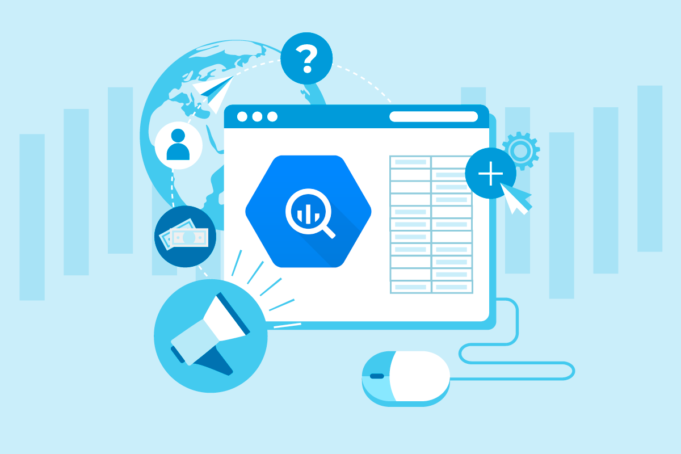In today’s world, companies collect a lot of data. They gather information about how well their products work, what customers do, and how the market is changing. And this data keeps getting bigger and bigger.
Data is really important. It helps companies make smart choices, run their business better, and stay ahead of the competition. To make the most of all this data, companies need tools that can gather, store, and analyze it quickly and effectively. Google BigQuery is one such tool that’s great for this job.
What is Google Big Query and what are its Potential

Google BigQuery is a tool that helps businesses manage and analyze a lot of data. It’s easy to use and doesn’t need a server. You can find it on the Google Cloud platform. With BigQuery, you can safely store, study, and get back large amounts of structured and semi-structured data.
It works well with other Google tools, handles complicated SQL questions, and can deal with different types of data like CSV, JSON, and AVRO.
BigQuery is fast because of Dremel technology, Google’s special way of searching. It can search through terabytes of data in seconds and petabytes in minutes. It breaks big searches into smaller ones and does them at the same time, so even hard questions get answered quickly.
You can use BigQuery to dig deep into your data, finding hidden patterns and trends that can help you make smart decisions for your business.

Why choose Google BigQuery?
Google’s BigQuery has many advantages that make it great for businesses that need tools to store and analyze data. Here are the main ones:
1. Serverless architecture
BigQuery doesn’t need a server, so businesses don’t have to worry about managing data warehouse systems. This means they can focus more on analyzing data and making decisions.
You don’t need to install anything to use BigQuery. It’s all set up when you create your account. This makes things easier for IT teams, so they can spend their time and resources on other important tasks for the business.
2. Performance and Scalability
BigQuery is great at handling lots of data and growing as your needs change. It automatically adjusts to handle big datasets and hard questions without slowing down.
The platform adds more computing power when it’s needed, so it can keep running fast and efficient. It also has features for machine learning, business insights, and looking at maps and locations.
3. Flexible pricing based on usage
BigQuery has a pricing system that adjusts to how much you use it. Companies only pay for what they actually use. This means they don’t have to pay for things they don’t use or commit to a fixed contract. It gives organizations more control over their spending and lets them manage their investments better.
4. Integration with Google services
BigQuery works well with other Google Cloud services like Google Drive, Cloud SQL, and Looker Studio. This makes it easy to collaborate and share data between different tools.
When you use BigQuery with other Google services, it’s simpler and more organized to bring in, store, and look at your data.
5. Machine Learning
BigQuery makes it easy for data scientists to create and use machine learning models right in the platform.
With simple SQL commands, you can make personalized models without moving your data anywhere else. This means you can quickly find useful insights and make better business decisions.

6. Real-time data analysis
Google’s data processing service, Dataflow, works together with BigQuery. This combination lets companies bring in data in real time and access it right away.
It’s a cool feature that helps organizations make decisions using the most recent and accurate data available.
The Importance of Performance in Data Analysis with Google Big Query
What sets Google Cloud BigQuery apart is how fast it can analyze data, thanks to Google’s Dremel technology.
BigQuery can search through lots of data super quickly. It can look through terabytes of data in seconds and even petabytes in minutes. By breaking down big searches into smaller ones and doing them at the same time, it gives you results right away, even for tough questions.
This super-fast searching not only helps businesses run smoother, but it also lets them dig deep into their data. They can find important patterns and trends that help them make smart decisions for their business.
When to use Google Cloud BigQuery
Now that we’ve looked at some of the big benefits and cool features of Google BigQuery, let’s check out some simple ways to use it and get the most out of this awesome tool.
1. Ad-Hoc Queries
BigQuery changes how data scientists find important information in their data, thanks to its fast processing and easy-to-use interface.
It’s made for situations where users need to quickly ask questions and get answers from really big sets of data. This helps them make decisions faster and more efficiently than before.
2. Complex analytical questions
When you’re dealing with tricky questions and lots of data, BigQuery is the best choice.
It uses advanced tech to help businesses find important information and discover hidden trends quickly, no matter how big or hard the data or questions are.
3. Predictive analytics
With machine learning and connecting different tools, companies can use their data fully. They can make predictions and find important information. This helps them stay ahead in their market.
4. Real-time analysis
In today’s fast-changing world, having up-to-date information is really important for making smart decisions fast.
By working with Google Cloud Dataflow, companies can keep an eye on data as it comes in and respond quickly to any changes. This helps them spot trends and catch any fraud happening right away.

5. Data storage
BigQuery does more than just analyze data—it also stores it. It’s a fully managed system, so companies can keep all their data in one place without needing to worry about servers.
This helps organizations keep their data organized and easy to manage. With everything in one place, they can use their resources better and focus on growing their business.
Best Practices for Using BigQuery
To make the most of Google Cloud BigQuery, it’s important to follow some helpful tips.
First, design your tables efficiently. BigQuery organizes data in a vertical way, so make sure to use this to your advantage. Only select the columns you need for fast and efficient queries. Also, optimize your queries to avoid getting unnecessary data and use indexes to speed up searches.
Keep an eye on how much resources you’re using and make sure your data stays secure by managing who has access to it.
Lastly, keep learning about new features and improvements in BigQuery. It’s always getting better, so staying updated can help you do more with your data. Following these tips can help businesses use Google Cloud BigQuery to its fullest potential.
The latest thoughts on Google Big Query
Google BigQuery is a strong and safe way to keep, handle, and study lots of data. It works well with other Google services and charges you based on how much you use it, which makes it great for all kinds of businesses.
With Google’s BigQuery, companies can make the most of their data. They can make smart choices, be more creative, and stay ahead in their field.

Emma Waterhouse
Writer and Editor-in-Chief at SereneWings






















